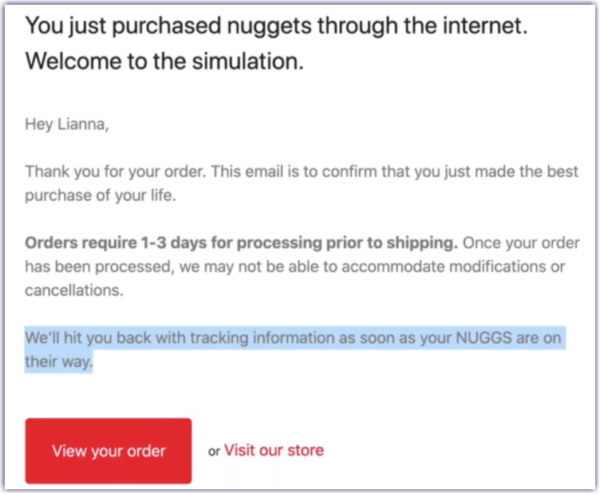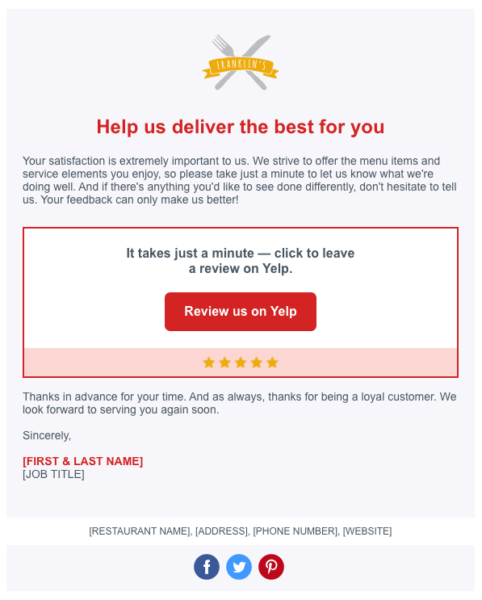
It’s easy to think that your work is done once customers complete their purchases. In reality, brands can benefit hugely from keeping in touch with their customers after their purchases. The right post-purchase communication can be the start of a long, valuable relationship with the customer. Post-purchase emails, in particular, are a cost-effective and impactful way to further that relationship.
Introduction to post-purchase emails
So, what are post-purchase emails? Post-purchase emails include a variety of different email marketing messages brands send to customers who have already completed at least one purchase. A message thanking the customer and showing your appreciation is one example of a post-purchase email.
Typically, brands send post-purchase emails soon after the customer makes the purchase. For example, an order confirmation email should go out immediately to assure the customer that their purchase went through successfully and give them a chance to make any necessary changes. Waiting more than a few weeks to send your post-purchase follow-up email may make the message less effective since your brand is no longer fresh in the customer’s mind.
The value of post-purchase emails
These post-purchase communications aim to build trust and customer loyalty, which will, in turn, increase customer lifetime value (CLV). CLV measures the total amount a company will generate from a customer over the entirety of their relationship. Customer A, who only ever buys one $50 product from a company has a CLV of $50, but Customer B, who buys one $50 product from the company every year for ten years, has a CLV of $500.
But how do after-purchase emails factor into CLV? They aim to turn Customer A into Customer B, a loyal returning customer who creates more value for the brand. Compared to other marketing emails, these emails have open rates that are 17% higher. They also offer 90% more revenue per recipient than pre-purchase emails. Simply put, post-purchase emails are too valuable for brands to ignore as part of their email marketing strategy.
Types of post-purchase emails
There are many different types of post-purchase emails you can send to customers depending on your goals and preferences. Here are some of the most common post-purchase email examples:
Order confirmation emails and brand reinforcement
Immediately after the customer completes a purchase, brands can send order confirmation emails. These emails typically contain a list of the products the customer purchased, their quantity and prices, the total sale amount, and other purchase details.
Customers generally expect order confirmation emails and may become concerned that something is wrong with their order if they don’t get this message. Make sure to send an order confirmation to the customer as soon as possible to ensure they know their order is progressing properly. Also, include information for contacting customer support in case there are any issues.

Shipping and delivery confirmation emails
Shipping and delivery confirmation emails are similar to order confirmation emails in that they are straightforward transactional emails brands send after purchase. Companies send a shipping confirmation once they ship the order and the package is on its way to the customer. Similarly, they send delivery confirmation emails once the package has arrived at the customer’s door.
These after-purchase emails keep customers in the loop about what’s going on with their orders. They provide some peace of mind to customers and can head off concerns about when packages will be delivered.
Engaging customers with educational content
As the expert on your products, you have valuable information you can share with customers who have already completed purchases. Tutorials on how to use the product, advice on how to get the most out of it, and answers to common questions all make great educational content to include in post-purchase emails.
The information you share with customers in these messages will engage them and keep them thinking about your brand, two benefits of email marketing. You can also reduce support center requests by addressing frequent concerns or questions before they become problems. Leverage existing blog posts or other content you’ve already produced to reduce the workload in creating these educational after-purchase emails.
Thank you emails and customer appreciation
It’s common to thank customers in the order or delivery confirmation emails, but a separate post-purchase thank you email is a great way to highlight your appreciation for your existing customers. In these thank-you emails, you can share some more information about your brand or the products the customer purchased to engage them.
Some brands choose to include a token of their appreciation in this email such as a special discount or a surprise free gift. Even if you just send a heartfelt thanks to your customers, though, that can go a long way toward building strong customer loyalty.
Loyalty and referral program emails
An after-purchase email is an ideal way to inform existing customers of loyalty or referral programs. Share the basic details of your program and the ways it benefits your customers to entice them to join.
If your customer loves the product, telling their friends and family about it helps everyone. Your business gets more customers, the family and friends get to purchase a great product, and the referring customer gets the benefits from the referral program. Loyalty and referral program emails provide additional incentives for customers to continue shopping from your company and to recommend your products to others.
Review requests and feedback solicitation
Strong reviews and feedback from existing customers make an incredibly powerful tool in your marketing efforts to gain new customers. Ratings and reviews are one of the top factors customers use to evaluate products, and 93% of customers say the content of these reviews affects whether they buy specific products or services. Unfortunately, only between 5% and 10% of customers write reviews after purchase. Increase reviews on your products by sending review request emails after customers complete a purchase.
Positive reviews provide strong social proof to prospective customers. Negative reviews are still useful, though, since they provide information you can use to improve the customer experience. Keep your feedback solicitation email short and consider offering an incentive for providing feedback to increase responses.

Cross-sell and upsell opportunity emails
Once a customer has made a purchase, you can send highly targeted emails promoting cross-sell or upsell opportunities. Cross-selling involves selling the customer different but related products to the one they already purchased. These related products pair well together and add value to one another. Upselling is similar — it’s selling the customer a bigger or better version of what they already bought.
Your customers may not be aware of the other products in your catalog that would complement or augment their previous purchase. Cross-sell and upsell emails are a way to make them aware of those opportunities and hopefully increase a customer’s lifetime value. They’re some of the best email drip campaigns to promote your business.
User-generated content and community-building
Like reviews, user-generated content (UGC) of your products serves as strong social proof that entices other consumers to purchase from your brand. Increase UGC by reaching out to previous customers and requesting that they post about your products on social media sites. Customers sharing their stories about their experiences with your product seem more authentic and persuasive to viewers than in-house promotional content.
Consider offering an incentive like a discount for customers who create content with your products. In the email, instruct them to use a certain hashtag so you can find the posts they create.
Best practices for crafting post-purchase emails
Employ these practices to craft the best post-purchase emails:
- Focus on your messaging: The way you phrase your post-purchase messages will have a significant impact on how successful those messages are. Keep the text short and direct while maintaining your established brand voice.
- Create compelling subject lines: After-purchase emails will only help your business if customers actually open and engage with them. Boost your open rates by writing clear, intriguing subject lines, such as, “We’ve shipped your order!” for a shipping confirmation email.
- Time your messages wisely: Send order confirmation emails right away, but don’t bombard the customer with all the other types of after-purchase emails immediately. Review request emails, for example, should arrive after the customer has had enough time to use and understand the product.
- Segment customers for targeted messaging: The same after-purchase messaging may not be right for all your customers. Consider breaking your customers down into segments based on their purchasing behavior and creating different after-purchase emails for these separate groups.
- Personalize your emails: Customers open emails that are personalized 26% more often. Include the customer’s name or other relevant details to make your after-purchase emails more impactful.
- Use A/B testing: A/B testing involves sending out two different versions of an email to see which performs better. You can use this strategy to learn more about what makes some after-purchase emails more successful than others with your customers.
How to create a post-purchase email workflow
Manually writing and sending messages to all your customers after they complete a purchase simply isn’t feasible. Instead, use a post-purchase email automation system to ensure your customers receive these important messages.
Within email marketing software like Constant Contact, you can create automated email workflows for your post-purchase emails. You specify the action that triggers one of your pre-created post-purchase emails — such as placing an order — and that email will automatically go out to the customer when they complete that action.
Create a new workflow for your after-purchase email in your email software. Then, select an applicable template for the email, adjust the content, and design to meet your needs. Ensure the software will fill in the personalized details about the customer, like their name and purchase information. Save these settings and send a test email to make sure this automated workflow works as intended.
Constant Contact makes the process of creating a post-purchase email workflow simple. Sign up for free to see the platform in action and decide if it’s right for you.
Post-purchase email benchmarks and metrics
Measure critical post-purchase email campaign benchmarks and metrics like you would with any other email marketing campaign. Keep an eye on metrics such as:
- Open rate
- Click-through rate
- Conversion rate
- Bounce rate
- Response rate (when applicable)
Remember that you shouldn’t hold post-purchase emails to the same benchmarks as general marketing emails to prospective consumers. For example, your open rate on after-purchase emails should typically be higher than your general open rate. Monitoring these metrics will help you find any weaknesses in your after-purchase emails and improve them.
Don’t miss out on the benefits of post-purchase emails
Post-purchase emails are powerful marketing tools that can greatly increase customer engagement, loyalty, and lifetime value. Some brands may find upselling and cross-selling emails more useful than referral program emails, for example, but after-purchase messages in general are almost always an effective strategy.
By creating some automated post-purchase email workflows, you’ll stay in contact with existing customers and encourage them in several ways to make additional purchases. Put after-purchase emails into place for your business and see the difference it will make.




